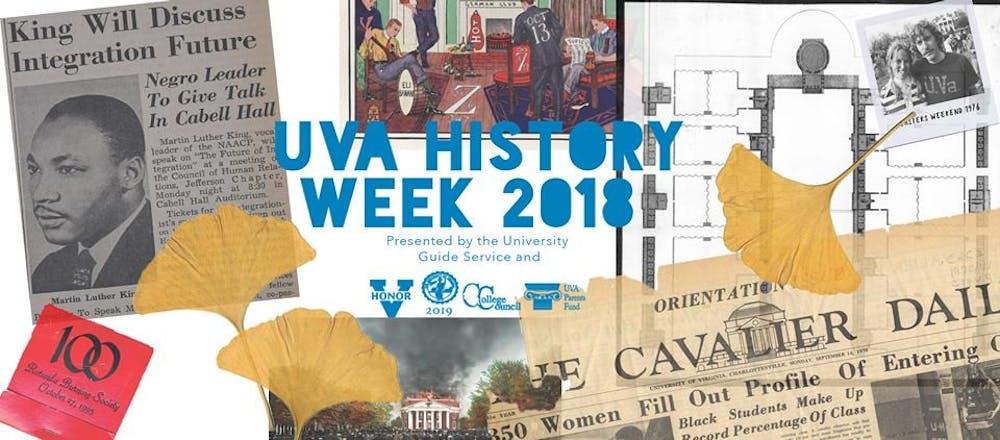The University Guide Service hosted their History Week March 19-23, which consisted of a dinner discussion, poster displays and extra tours.
“The main goal of History Week is just a varied, week-long event series to promote historical knowledge of U.Va. to students,” said Tucker Wilson, historian for U-Guides and a second-year Engineering student who worked on planning the week.
The last time U-Guides held History Week was 2011, but the event reportedly dates back to the 1980s.
“The first mention of it I found was in a Cav Daily article in, I believe, 1980, while I was researching another history project,” Wilson said. “The only activity they mentioned in the article was Guides serving peach brandy to students who wanted to come by, so I didn't have a ton to work on.”
Wilson said he worked to revive History Week because of his belief in the importance of sharing the University’s history.
“I’m really impassioned about sharing all of this history,” Wilson said. “I hope that in these small ways we can impact students’ lives and [give] them more complete, more concrete ways to understand this place we call home.”
The main events for the week were supposed to be two dinner discussions on the complex history of the University, but the first one was cancelled due to snow Wednesday.
The cancelled Wednesday dinner was supposed to take place in the Rotunda and focus on the history of space at the University. Kirt von Daacke, assistant dean and history professor, was scheduled to speak on the landscape of the University, its roots in a system of slavery and the legacy that slavery leaves today.
The second dinner, held Friday evening in Hotel E, was centered around several roundtable discussions between students and faculty about how to grapple with the University’s history today.
The event featured George Gilliam, a history lecturer and historian, Ervin Jordan, an associate professor and research archivist at the Albert and Shirley Small Special Collections Library, and Douglas Blackmon, former host of the Miller Center’s “American Forum” television program and a Pulitzer Prize winner for his work on re-enslavement of African American people after the Civil War. Additionally, Wayne Cozart, who is Alumni Association’s vice president of development, Preston Reynolds, a top researcher on U.Va.'s history of eugenics and Andrew O’Shaughnessy, history professor and vice president of the Thomas Jefferson Foundation at the Monticello, attended the event.
Over dinner, students and professors discussed the University’s complex history, ranging from the Confederate plaques on the Rotunda that were approved for installation in 1903 to the white supremacist rallies of Aug. 11 and 12. The Board of Visitors voted to remove the plaques following the events in August, and the University removed them shortly thereafter.
Alongside these topics, there was much discussion on how to help students to better understand the school’s history.
“I think there are substantial efforts [by the University] to correctly portray our history … but I don’t think the University has done a good enough job engaging in its history,” said Brendan Nigro, former U-Guides chair and a third-year College student who will serve as the next student member of the Board of Visitors. “[The history] is not taught in any required class, there’s not an orientation session for it.”
Students also discussed where to go with the future.
“Sometimes, we aren’t the ones most affected by things… but you can’t just say, ‘No, I’m tired,’” third-year College student Angie Aramayo said. “I think there is a perfect line [between activism and living everyday life], and we can walk that.”
In addition to the dinner, U-Guides put up poster displays in important spots on Grounds, like Alderman and Clemons Library and the slavery plaque under the Rotunda. U-Guides also placed slips of paper on Lawn room doors, giving out a QVR code that can be scanned to pull up the story of a person who once lived in that room.
Each day during the week, U-Guides offered two extra historical tours, along with two tours focusing on the history of African Americans and the history of women on Grounds. While each Guide makes their own tour, almost all go by the slavery plaque underneath the Rotunda and the gardens.
Wilson shared the story of Wesley Harris, a black student and activist, who invited Martin Luther King Jr. to give a speech at Old Cabell Hall in 1963, something that is almost always mentioned on the History of African Americans tour as groups pass the building.
“The night before the speech, Harris and MLK were walking … and a car backfired — and a car backfiring sounds a lot like a gunshot — so Harris threw himself on top of King in an effort to save his life … I think it’s cool that a 21-year-old student would be able to sacrifice his life for something he believed in.”
U-Guides passed out stickers throughout the week sporting slogans such as “By God, I think they’re here to stay,” which was the headline of a Cavalier Daily article from Sept. 14, 1970 after women were admitted to the University.







